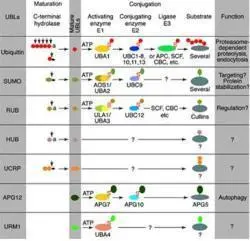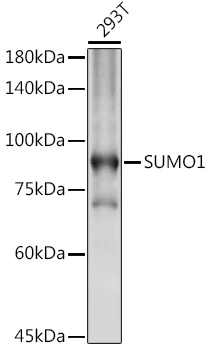
Sumo antibody
GTX48821
ApplicationsWestern Blot, ELISA
Product group Antibodies
TargetSUMO1
Overview
- SupplierGeneTex
- Product NameSumo antibody
- Delivery Days Customer9
- Application Supplier NoteWB: 1:500-1:3000. ELISA: 1:5000-1:25000. *Optimal dilutions/concentrations should be determined by the researcher.Not tested in other applications.
- ApplicationsWestern Blot, ELISA
- CertificationResearch Use Only
- ClonalityPolyclonal
- Concentration5 mg/ml
- ConjugateUnconjugated
- Gene ID7341
- Target nameSUMO1
- Target descriptionsmall ubiquitin like modifier 1
- Target synonymsDAP1, GMP1, OFC10, PIC1, SENP2, SMT3, SMT3C, SMT3H3, UBL1, small ubiquitin-related modifier 1, GAP modifying protein 1, SMT3 homolog 3, SMT3 suppressor of mif two 3 homolog 1, sentrin, ubiquitin-homology domain protein PIC1, ubiquitin-like protein SMT3C, ubiquitin-like protein UBL1
- HostRabbit
- IsotypeIgG
- Protein IDP63165
- Protein NameSmall ubiquitin-related modifier 1
- Scientific DescriptionCovalent modification of cellular proteins by the ubiquitin-like modifier SUMO (small ubiquitin-like modifier) regulates various cellular processes, such as nuclear transport, signal transduction, stress responses and cell cycle progression. But, in contrast to ubiquination, sumoylation does not tag proteins for degradation by the 26S proteasome, but rather seems to enhance stability or modulate their subcellular compartmentalization. Ubiquitin-like proteins fall into two classes: the first class, ubiquitin-like modifiers (UBLs) function as modifiers in a manner analogous to that of ubiquitin. Examples of UBLs are SUMO, Rub1 (also called Nedd8), Apg8 and Apg12. Proteins of the second class include parkin, RAD23 and DSK2, are designated ubiquitin-domain proteins (UDPs). These proteins contain domains that are related to ubiquitin but are otherwise unrelated to each other. In contrast to UBLs, UDPs are not conjugated to other proteins. Once covalently attached to cellular targets, SUMO regulates protein:protein and protein:DNA interactions, as well as localization and stability of the target protein. Sumoylation occurs in most eukaryotic systems, and SUMO is highly conserved from yeast to humans. Where invertebrates have only a single SUMO gene termed SMT3, three members of the SUMO family have been identified in
- Storage Instruction-20°C or -80°C,2°C to 8°C
- UNSPSC12352203




![ICC/IF analysis of C-33A cells using GTX00701 SUMO1 antibody [4D12]. SUMO-1 colocalizes with SUMO2/3. Left : anti-SUMO-1 antibody (4D12) Middle : anti-SUMO2/3 antibody (3H12) Right : Merged image Dilution : 10 microg/ml](https://www.genetex.com/upload/website/prouct_img/normal/GTX00701/GTX00701_20191104_ICC-IF_1_w_23053121_395.webp)
![ICC/IF analysis of HEK293A cell using GTX00842 SUMO1 antibody [4D12] (FITC). Scale bar : 50 mm Dilution : 1:50](https://www.genetex.com/upload/website/prouct_img/normal/GTX00842/GTX00842_20200406_AP_002_129_w_23053121_519.webp)
![FACS analysis of paraformaldehyde-fixed HepG2 cells using GTX35092 SUMO1 antibody [SM1/495]. Blue : Primary antibody Red : Isotype control](https://www.genetex.com/upload/website/prouct_img/normal/GTX35092/GTX35092_20200115_FACS_1657_w_23060801_235.webp)
![IHC-P analysis of human ovarian carcinoma tissue using GTX35093 SUMO1 antibody [SPM571].](https://www.genetex.com/upload/website/prouct_img/normal/GTX35093/GTX35093_20200115_IHC-P_834_w_23060801_876.webp)
![IHC-P analysis of human testicular carcinoma tissue using GTX35094 SUMO1 antibody [SUMO1/1188].](https://www.genetex.com/upload/website/prouct_img/normal/GTX35094/GTX35094_20200115_IHC-P_1211_w_23060801_906.webp)